Budget Debate Preview: Cops, Leaves
The main item on the Ann Arbor city council’s May 19, 2014 agenda is the adoption of the budget for the 2015 fiscal year, which starts on July 1, 2014.

Ann Arbor city administrator Steve Powers at the council’s May 12, 2014 working session. He presented his recommended FY 2015 budget to the council in April. The council can amend that budget on May 19.
Under the city charter, the council needs to adopt the budget, with any amendments, on a seven-vote majority. If the council is not able to achieve a seven-vote majority on an amended budget, then under the city charter, the city administrator’s proposed FY 2015 budget will be adopted by default.
At the conclusion of a May 12 city council work session, Tom Crawford, the city’s chief financial officer, reminded councilmembers of the constraints they were working under when considering budget amendments. The forecast for fiscal year 2014, he told the council, is that about $1.5 million in the fund balance reserve will be used – which compares to the budgeted use of about $2.8 million of fund balance.
But Crawford cautioned that the unspent budgeted amount likely reflected a delay in that spending, not an actual savings. Crawford expected that the fund balance reserve at the end of FY 2014 would be about 10% of operating expenses.
The proposed FY 2015 budget would use $2.8 million in fund balance, Crawford told the council, which would take the fund balance down to the 7-9% range. That’s the bottom of the minimum 8-12% range that has been the council’s policy. “I say all that because I want to remind you that you’re entering a budget deliberation with pretty tight constraints,” Crawford said. So Crawford encouraged the council to find offsets to any additional expenses they wanted to incur – whether those were recurring or non-recurring expenses.
Councilmembers were asked to submit drafts of their proposed amendments to staff by the close of business on Thursday so that staff could assist in crafting the amendments. This report includes some additional background on what’s in the budget, as well as a description of 17 possible budget amendments that might be proposed.
Detail is provided on amendments in three areas: police staffing, leaf/compost collection and the local development finance authority (LDFA).
Outline of Possible Amendments
Here’s a bulleted list of possible amendments, not necessarily exhaustive, with potential councilmember sponsors in parens:
- Police staffing. One proposal would increase the number of sworn police officers by five officers instead of an increase of three proposed by the city administrator. Funding would come in part from a reduction in the 15th District Court budget. (Jane Lumm, Jack Eaton, Sumi Kailasapathy) An alternative proposal would increase the number of sworn officers by two officers instead of three, with the savings allocated to human services for the purpose of drug treatment and prevention. (Chuck Warpehoski)
- Forestry staffing. The proposal would add a city forester position. The funding for the initial year would come from eliminating a proposed corridor study planned for Ellsworth Road. (Eaton)
- Compost/leaf program. One proposal would restore loose leaf collection in the fall and holiday tree pickup in the winter. This would require roughly $406,000 in capital investment and $319,500 in recurring expenses from the millage-supported solid waste fund. (Lumm, Eaton, Kailasapathy) A different proposal would extend the curbside compostables pickup from seasonal to year-round so that food waste could be kept out of the garbage stream year-round, at an increased annual cost of $300,000. (Sabra Briere)
- LDFA, Ann Arbor SPARK. One proposal would eliminate some increases in the budget of the local development finance authority (LDFA) – of $30,000 in incubator operating expense, $20,000 in direct staffing expense, and a $75,000 increase to Ann Arbor SPARK’s marketing plan. Those funds would instead be reserved for “future infrastructure improvements.” (Kailasapathy, Eaton) A separate proposal would eliminate the city general fund allocation of $75,000 to Ann Arbor SPARK and put that money toward human services instead. (Kailasapathy, Eaton)
- Animal control. The proposal would eliminate funding for an inventory of commercial signs in favor of animal control for the Human Society of Huron Valley and for deer herd management costs. (Sally Petersen, Kailasapathy, Eaton)
- Art administration, traffic calming efforts. The proposal is to reduce the amount allocated in the recommended budget for transitional costs associated with the public art program from $80,000 to $40,000. The $40,000 in savings would be used for traffic calming projects in neighborhoods, including but not limited to speed bumps. (Eaton, Kailasapathy)
- 415 W. Washington demolition. One proposal would use about half of the $300,000 in the general fund budget that’s designated for demolition of the city-owned 415 W. Washington property to fund the pedestrian safety and access task force. (Briere, Warpehoski) A separate proposal would simply eliminate general fund support for demolition of the city-owned buildings at 415 W. Washington. (Kailasapathy, Lumm, Eaton)
- Community-facing climate action programs. Money for “community-facing” climate action programs would come in part from $50,000 allocated for the Ellsworth Road corridor study. (Christopher Taylor, Margie Teall, John Hieftje, Warpehoski)
- Warming center. This proposal would allocate $100,000 from the affordable housing trust fund to provide assistance for a warming center. (Lumm, Briere)
- Streets. A proposal about alternative transportation would, for this year, bump the Act 51 allocation for alternative transportation from 2.5% to 5% – which translates to $180,000. The amendment would ask the city administrator to provide information that would help the council determine the appropriate percentage to allocate to alternative transportation. (Briere) A separate resolution would not alter the budget but would ask the city administrator to “study alternatives to increase street funding and present to Council by Sept. 30, 2014 a report outlining options, their financial impact, and the pros and cons of each.” (Lumm, Eaton, Kailasapathy)
In addition to these budget amendments, it’s possible that a resolution will be put forward by Jane Lumm (Ward 2) directing the city administrator to develop a revised retirement plan design for new hires that “includes a defined contribution element and results in lower costs to the city.” The new plan design would be presented to the council by Dec. 31, 2014, with the intent that the revised plan would be applied to all employees hired after Dec. 31, 2015.
FY 2015 Budget Background
Ann Arbor city administrator Steve Powers’ proposed general fund budget for fiscal year 2015, which starts on July 1, 2014, approaches $100 million. [.pdf of FY 2015 budget detailed breakdown] Powers presented the budget to the council at the council’s second meeting in April, as required under the city charter.
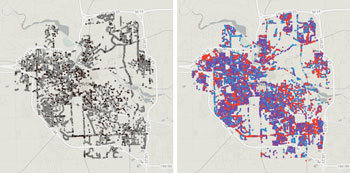
Left: Stumps (black) and vacant sites (gray). Right: Maples (purple), Crabapples (red) and oaks (blue). Maps by The Chronicle from the city’s 2009 tree inventory.
Funded as part of the proposed FY 2015 budget are five new full-time employees, four of them in public safety: one additional firefighter; three additional police officers; and an additional rental housing inspection position. The additional police positions will bring the total number of sworn officers in the city of Ann Arbor to 122.
The proposed budget also includes a one-time expense of $1 million to address a backlog in critical pruning and removal of trees that are in the public right of way. The allocation comes in the context of the development of an urban forestry management plan.
The $1 million one-time expense for street trees brings the total of non-recurring expenses in the FY 2015 general fund budget to about $2.8 million. Other one-time expenses budgeted for FY 2015 are: $80,000 to cover transitional costs for public art administration; $606,000 for repairs and maintenance of the city’s hydroelectric dams; $100,000 for consultants to assist with completing the downtown zoning amendments and sign inventory; $300,000 for demolition of city-owned buildings at 415 W. Washington; $200,000 for corridor studies; and $209,000 in operational support for the Ann Arbor Housing Commission’s (AAHC) transition to a rental assistance demonstration program.
The housing commission also accounts for the bulk of a $13.8 million (17%) increase in general fund recurring expenditures compared to last year. That’s due to an accounting change that recognizes 22 AAHC employees as city employees. By recognizing revenue and expenses for AAHC employee compensation through the general fund, the AAHC can avoid the negative impact of a new accounting rule. The GASB 68 rule requires unfunded pension fund liabilities to be recorded in the financial statements for proprietary funds (like the AAHC) but not for governmental funds like the general fund.
Also included in the FY 2015 budget proposal is about $3,000 for a pilot program for closed captioning of public meeting broadcasts on the Community Television Network. According to city of Ann Arbor communications manager Lisa Wondrash, the cable commission recommended approval of the money at its Feb. 25 meeting, and she notified the commission on disability issues about the pilot on April 16. The pilot will begin with meetings of the city’s commission on disability issues, with a goal of testing out a closed captioning system this July.
The $98.1 million of general fund expenditures in FY 2015 will include $95.3 million in recurring expenditures and $2.8 million in one-time expenses.
When the general fund is added in with the rest of the city’s budget – the street fund, water fund, sewer fund, parking fund, and the like – the total expenses proposed for FY 2015 come to $334,434,101.
Loose Leaf Collection, Holiday Trees
Until 2011, the city of Ann Arbor offered an option to residents for the pickup of leaves that allowed residents to sweep their leaves into the street for collection.
The city collected the leaves using street sweepers as pushers, front-end loaders and rented large-volume trucks. The city offered two such pickup days for all parts of the city. As part of the general strategy for moving to wheeled carts for all types of curbside pickups (including garbage and recycling) – which can be serviced by a mechanical arm controlled from a truck cab – the city made compost carts available to residents. The city also still picks up leaves that are “containerized” in paper bags.
The proposed FY 2015 budget does not provide for the loose leaf collection service. Jane Lumm (Ward 2) will likely bring forward an amendment to restore the leaf collection service, as well as holiday tree pickup. According to a staff memo responding to questions about the financial impact, restoration of the program would require $406,000 in one-time capital costs for the additional equipment, and a total of $319,500 in additional recurring annual costs. That’s been roughly the same financial picture the council has been provided in the two previous years.
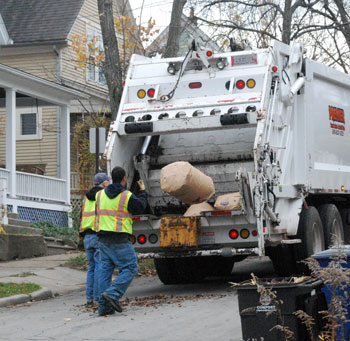
A truck rented from Premier Truck Sales & Rental for fall containerized (paper bagged) leaf pickup – action back in 2011 on the Old West Side in Ann Arbor.
Last year on budget night, at its May 20, 2013 meeting, the council deliberated over an hour on the restoration of loose leaf collection in the fall. That was the second-longest amount of time spent on any topic. [The longest amount of time was spent by the council on the Ann Arbor Downtown Development Authority budget – about an hour and a half.] It did not result in the restoration of the mass leaf collection service. The proposal failed on a 4-7 vote, with support from Jane Lumm (Ward 2), Sally Petersen (Ward 2), Mike Anglin (Ward 5), and Sumi Kailasapathy (Ward 1).
That was two more votes than the proposal to restore loose leaf collection got the previous year, during the council’s May 21, 2012 FY 2013 budget deliberations. Joining Lumm and Anglin in support that year was only Tony Derezinski (Ward 2).
Compared to last year, the proposal will likely pick up at least one vote – from Jack Eaton (Ward 4), who prevailed over Marcia Higgins in last year’s Democratic primary. But that would leave it one vote shy of the six votes needed to amend the budget.
Loose Leaf Collection: Possible Points of Debate
Context for this item includes the fact that funding for curbside collection of leaves – whatever the method – comes from the solid waste fund, which is supported by a tax at a rate of 2.467 mills. That generates roughly $12 million a year. The proposal from Sabra Briere (Ward 1) to extend compost collection – using curbside carts as well as paper bags – from seasonal to year-round collection would cost about the same as Jane Lumm’s proposal to add loose leaf collection and holiday tree pickup. Either proposal would cost roughly $300,000.
The two proposals intersect on one relatively small point – the pickup of holiday trees, which has a standalone cost of roughly $26,000. Extending compost collection to year-round service could have the practical effect of providing pickup of holiday trees – because many such trees would fit inside the compost carts or could be chopped to fit inside them. Briere’s interest in extending compost pickup to year-round service is motivated by a desire to allow the city’s food scrap composting program – implemented for the first time this spring – to operate year-round.
Briere’s proposed amendment would expect the $300,000 in annual costs to be recovered in part through reduced landfill tipping fees for garbage – as the weight from food scraps would be diverted from the garbage stream. Based on a city sampling of the contents of garbage trucks, about half of the weight is attributable to food waste. So if all of the food waste were eliminated from the garbage stream, the city could expect to cut its tipping fees for residential garbage by half.
Data from the city indicates about 14,500 tons of residential curbside trash picked up in FY 2012. Reducing that figure by half would result in a savings of just $195,000 – based on a tipping fee of $26 a ton paid by the city. Those fees could increase, however, as the city’s contract with the landfill expires in 2017.
Lumm is likely to argue that loose leaf collection is a basic service that residents can reasonably expect to be paid for from their taxes. Further, she’ll likely argue that the sheer volume of leaves that some residents contend with makes bagging the leaves or mulching them impractical, so that paying a private hauler is the only alternative for such residents. She’ll likely point to the current fund balance in the solid waste fund of $11.7 million as adequate to fund the acquisition of the necessary equipment to provide the service.
On the financial side, opponents of restoring the service will likely point to challenges faced by the solid waste fund: increases to tipping fees – as much as 50% – when the city’s landfill contract expires in 2017, construction of a new drop-off center, expansion of commercial food waste recycling, and expansion of multi-family recycling. Other considerations likely to be cited by opponents of restoring loose leaf collection could include localized flooding caused by leaves clogging storm drains, the road hazards to bicyclists and motorcyclists, and the increase in suspended solids that flow into the Huron River. One staff memo on the topic indicates that there’s been a 28% drop in service requests about plugged storm drains since the containerized approach was adopted.
On May 17, Janis Bobrin – former Washtenaw County water resources commissioner – sent an email to all councilmembers on the topic of localized flooding and particulate pollution caused by leaves in the street. Bobrin’s email received a quick reply from Lumm, who attached a photo of a leaf-clogged storm drain from April of this year. Lumm contends that storm drains get clogged with leaves with the containerized approach, because the streets are not systematically cleared of leaves as they would be if the mass loose leaf collection service were implemented.
Police Officer Staffing
The FY 2015 proposed budget would add three police officers – two in community engagement and one for traffic enforcement – bringing the count of sworn officers from 119 to 122. An amendment to be put forward by Jane Lumm (Ward 2), Jack Eaton (Ward 4) and Sumi Kailasapathy (Ward 1) would increase the number of sworn police officers by five officers instead of three. Funding would come in part from a reduction in the 15th District Court budget.
An alternative proposal from Chuck Warpehoski (Ward 5) would increase the number of sworn officers by two instead of three, with the savings allocated to human services for the purpose of drug treatment and prevention.
Last year on budget night, at its May 20, 2013 meeting, the council deliberated a bit under an hour on a proposal to reduce the 15th District Court’s budget by $270,000 and to use the recurring savings to hire three additional police officers. That proposal failed on a 5-6 vote – with support only from Lumm, Kailasapathy, Mike Anglin (Ward 5), Stephen Kunselman (Ward 3) and Marcia Higgins (Ward 4). A proposal to fund a single police position – by eliminating an FTE in the city attorney’s office through a retirement – received shorter debate and less support, with yes votes coming only from Lumm and Kailasapathy.
The previous year, Lumm put forward an unsuccessful amendment to add five police officers – in addition to five that would have been added if a Community Oriented Policing Services (COPS) grant was received. The five non-grant-funded positions would have been paid for with non-specific cuts to other city general fund departments: mayor and council ($8,957); 15th District Court ($94,617); public services ($192,265); and human resources ($35,939). The amendment also called for higher cost recovery for officers for which the Ann Arbor Area Transportation Authority (AAATA) contracts. And the amendment called for use of money designated for a high speed rail grant match. That 2012 budget amendment to add five police officers got support only from Lumm and Kunselman.
Police Officer Staffing: Historical Levels
At a May 12, 2014 work session, police chief John Seto gave the council an update on safety services. Among the data sets he presented were tables that showed the decrease in sworn officer staffing levels for the AAPD over the last 10 years, broken down by category of officer. He allowed that the staffing levels prior to 2005 were even higher.
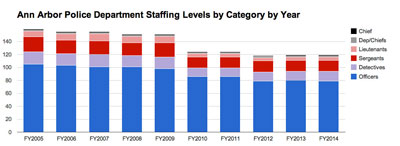
Ann Arbor Police Department sworn officer staffing levels by category: 2004-2014. The significant decrease from FY 2009 to FY 2010 was the result of several officers taking advantage of an incentivized early retirement offered by the city. Those positions were not filled. (Data from the city of Ann Arbor, chart by The Chronicle.)

Ann Arbor Police Department sworn officer staffing levels by category: 2004-2014 with proposed levels for FY 2015. (Data from the city of Ann Arbor, chart by The Chronicle.)
In his work session presentation to the council, Seto pointed out that the category of lieutenants and sergeants had decreased more than sworn officers overall, which he indicated was a result of flattening the organization so that it was administratively lighter. Computing the ratio of officers in the lieutenant and sergeant category to the other officers illustrates the drop Seto described:

Ratio of lieutenants and sergeants to other officers in the Ann Arbor Police Department. (Data from the city of Ann Arbor, chart by The Chronicle.)
Police Officer Staffing: Crime Trends
At the May 12 work session, Seto also updated the council on major crime trends through the end of last year. He was reprising a presentation he’d given two months earlier at the council’s March 3, 2014 meeting. [.pdf Ann Arbor 2013 crime stats]
Part I crime totals for 2013 were 2,827, down from 3,059 in 2012. Part II crime totals for 2013 were 3,625, down from 3,883 in 2012. Total crimes for 2013 were 6,452, down from 6,942. That’s a 7% drop.
As he had in March, Seto stressed at the working session that the numbers being reported were not the official FBI numbers but they are the internal Ann Arbor police department numbers that are reported to the FBI. For 2013, he said, the year-end reported number of Part I crimes was 2,827. [Part I crimes include: criminal homicide, forcible rape, robbery, aggravated assault, burglary (breaking or entering), larceny, motor vehicle theft and arson.] That represented about an 8% reduction compared to the previous year, Seto said. These statistics don’t include those from the University of Michigan, which reports its crimes separately.
At the work session, Seto cautioned that crime statistics only tell part of the story. He said it’s important also to consider what the community wants and what makes them feel safe, which can include consideration of nuisance-type crimes that might not make it into Part I crime stats.
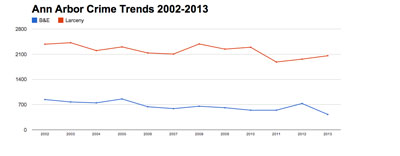
Ann Arbor crime statistics from 2002 through 2013 for larceny (red) and burglary (blue). (Data from the AAPD. Chart by The Chronicle.)

Ann Arbor crime statistics from 2002 through 2013 for Part I crimes except for larceny and burglary. (Data from the AAPD. Chart by The Chronicle.) The downward trend is consistent in every category except for sexual assault crimes (red).
At the work session, the increasing trend for sexual assault was highlighted by Sally Petersen (Ward 2), who wanted to know if Seto thought it could be in any way related to the increase in prosecuted heroin cases – from 5 in each of 2011 and 2012 to 15 cases in 2013. Seto did not think there was a connection, but noted that the majority of sexual assault cases the department sees involve an assailant who is known to the victim.
The yearly departmental figures presented by Seto are consistent with the monthly breakdown charted out by The Chronicle using data from crimemapping.com over the last three years:
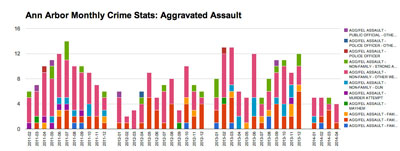
Ann Arbor Monthly Crime Stats: Aggravated Assault (Data from crimemapping.com, chart by The Chronicle)
Police Officer Staffing: Possible Points of Debate – Adequacy
At the city council work session, Seto was cautious in the way he characterized current staffing levels. He described patrol and detective staffing as “adequate,” saying he chose that word because he really felt that AAPD is doing a good job – an adequate job – of reacting, and doing follow-up and solving crimes. But that leaves little time for other things he also feels are important – which are community engagement and proactive policing, Seto said.
Seto’s statements will likely be used at the May 19 meeting for and against adding two additional officers beyond the three already in the recommended FY 2015 budget. His remarks will be used to support the idea that three additional police officers are not enough to accomplish what Seto would like to see. And councilmembers who are not inclined to add two more officers for a total of five will point to his choice of the word “adequate.”
At the May 12 work session, Jack Eaton (Ward 4) pressed Seto to describe his attitude toward the three additional officers: Was the addition of three officers “sufficient” to accomplish what Seto had described in terms of community engagement? Seto came back with his preferred vocabulary, saying: “It is an adequate start.” Seto said it’s difficult to predict the needs of the community.
Sometimes he’s heard that more police are needed downtown. Sometimes Seto has heard that more officers should be available to work with youth. Seto reiterated that the two community engagement officers are “an adequate start.” He continued saying that as police chief, he felt very comfortable with the excellent and professional officers that AAPD has to respond to crimes and to solve them. As far as community engagement and outreach, “I will always think that we can do more, if that’s the answer you are looking for,” Seto concluded.
Police Officer Staffing: Possible Points of Debate – Traffic Enforcement
One of the proposed new positions would be dedicated to traffic enforcement. This could also be part of the May 19 debate – as the council voted at its Dec. 16, 2013 meeting to allocate $125,000 in overtime for additional traffic enforcement for the last six months of the current fiscal year. Those six months run from Jan. 1 through June 30, 2014.
At the May 12 work session, Eaton made the point that this was the staffing equivalent of two FTEs for that six-month period. So it’s possible that he’ll make the argument that to maintain that level of enforcement activity, the city would need to add two officers dedicated to traffic enforcement – not just the one that’s recommended in the FY 2015 budget.
At the May 12 working session, Seto gave the council a breakdown of the activity that’s been funded by the $125,000 to date.
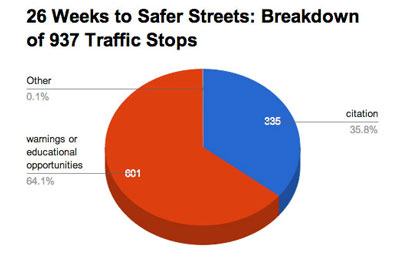
26 Weeks to Safer Streets: Breakdown of 937 Traffic Stops (Data from the city of Ann Arbor, Chart by The Chronicle)

26 Weeks to Safer Streets: Targets of Enforcement by Time (Data from the city of Ann Arbor, Chart by The Chronicle)
Police Officer Staffing: Possible Points of Debate – Human Services
A possible proposal to be brought forward by Chuck Warpehoski (Ward 5) would re-allocate the funding for one police officer to instead pay for human services to treat addiction and promote recovery. Seto’s remarks at the work session could be used to argue for that amendment. During discussion of the increased incidence of drug offenses – in particular, heroin – Seto delivered the following quote: “I would say very cautiously we’re not going to arrest our way out of this.”
Seto noted that the increase in heroin use is a trend that is not unique to Ann Arbor – but rather is noticeable throughout the county and the country. Addressing the issue would require a multi-disciplined approach that includes education and treatment for addiction. Solving the problem would require collaboration across multiple jurisdictions, Seto said. And he’s already spoken to the county sheriff and other police chiefs to talk about how they can manage the situation from a law-enforcement perspective.
Local Development Finance Authority: Infrastructure (Fiber?)
By way of background, the local development finance authority (LDFA) is funded through tax-increment financing (TIF) in a manner similar to the way the Ann Arbor Downtown Development Authority is supported. A TIF district allows authorities like the LDFA and the DDA to “capture” some of the property taxes that are levied by other municipal entities in the district. The district that yields TIF revenue for the LDFA has the same geography as the Ann Arbor DDA. The taxes that are captured are generated by the Ann Arbor Public Schools general operating millage.
If the LDFA did not exist, then the taxes collected on behalf of the AAPS for its general operating millage would not be used directly by AAPS, but rather would go to the state’s School Aid Fund, for redistribution among school districts statewide based on a per-pupil formula as determined on a specified “count day.” The state reimburses the School Aid Fund for the taxes captured by the LDFA.
The main contractor for the LDFA is Ann Arbor SPARK, which operates a business accelerator with LDFA funding. To the extent that the property valuation in the LDFA district (which is the same as the Ann Arbor DDA district) increases, the LDFA revenue budget also increases.
The possible amendment to the LDFA budget, which might be brought forward on May 19, would among other things eliminate $30,000 in increased incubator operating expenses, $20,000 in direct staffing expense, and a $75,000 increase to Ann Arbor SPARK’s marketing plan in order to reserve a total of $165,379 for “future infrastructure improvements.”
The nature of the infrastructure improvements is not specified in the budget amendment, which might be brought forward by Sumi Kailasapathy (Ward 1) and Jack Eaton (Ward 4). But if it’s approved by the council, it could give some direction to the LDFA board as that group contemplates its future spending in the coming years. The LDFA was established for a period of 15 years, which ends in 2018. But state legislation passed in 2012 could allow an extension for an additional 5 or 15 years.
The idea of using LDFA funds as infrastructure investments – specifically the kind of high-speed telecommunications infrastructure represented by fiber-optic networks – is made explicit in the LDFA’s formative documents. From the TIF plan [emphasis added]:
The LDFA District is fully developed with roads, sidewalks, lighting and subsurface utilities. The infrastructure is publicly financed and maintained. The Development Plan does not anticipate large-scale improvements to or expansions of this infrastructure. In the event sufficient revenues become available through this plan, investment may be made to facilitate the expansion of high-speed telecommunications infrastructure throughout the District. Alternatively, the LDFA may become a grant recipient for financing designed to encourage this investment.
The development of a high-speed fiber network is also highlighted in the final report of the economic collaborative task force, established by the council last year at its May 20, 2013 meeting. [.pdf of March 28, 2014 economic collaborative task force report]
Specifically, that report included a recommendation that the city consider technology infrastructure that is “essential for companies to compete globally and for communities to attract the necessary talent.” In that category of infrastructure, the report indicates that the city and Ann Arbor SPARK should “continue their work to develop a proposal for high-speed fiber that would accelerate both commercial and residential Internet speeds.”
Back in 2010, the LDFA had offered $250,000 in support of Ann Arbor’s response to the Google Fiber initiative. Around that time, Stephen Rapundalo, who represented the city council on the LDFA board, indicated that the LDFA would consider making an investment in a fiber-optic network, even if Google did not choose Ann Arbor as a test community. Google did not choose Ann Arbor.
At the March 15, 2010, public hearing on the Google Fiber initiative, former Congressman Wes Vivian urged the city council to think about how they would achieve a fiber-optic network, if Google did not choose Ann Arbor. [From Chronicle coverage: "Mixed Bag: Phones, Fiber, Fire"]:
Wes Vivian introduced himself as a decades-long telecommunications consultant, and told the council that for the last 15-20 years it’s been clear that either the telephone companies will migrate to fiber-optic networks or face domination by cable television companies. That process has begun, he said – AT&T has installed fiber in many communities.
If Google “coughs up the money” that’s great, Vivian said, but we need to find a way to implement this anyway – even if Google decides not select Ann Arbor as a test site. Fiber, he said, was part of the necessary infrastructure of a city – like a street. It wasn’t necessary to provide a system, he said, but just a hole in the ground or a hole in the air.
The idea of working on a “fiber-to-the-premises” project in the city was on the FY 2014 work plan for the city’s IT department, and was described by city administrator Steve Powers in an interview with The Chronicle as follows: “That is very important, and I think it’s part of place-making, part of having an environment that’s conducive to businesses and residents choosing to locate in Ann Arbor and stay in Ann Arbor. ”
The Chronicle could not survive without regular voluntary subscriptions to support our coverage of public bodies like the Ann Arbor city council. We sit on the hard bench so that you don’t have to. Click this link for details: Subscribe to The Chronicle. And if you’re already supporting us, please encourage your friends, neighbors and colleagues to help support The Chronicle, too!




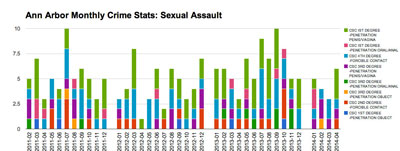
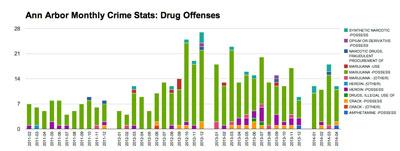
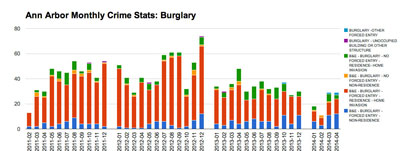
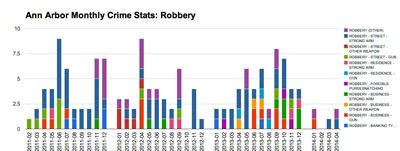
A distasteful aspect of this process is the method often used by Council members of robbing Peter to pay Paul. A perfectly worthwhile objective has funds taken to fill another objective. This means that some of us don’t know what side to cheer on.
Another is that funds are transferred based on faulty assumptions. A standout is CM Briere’s assumption that year-round compostable pickup will be paid for by a substantial reduction in tipping fees because of food waste diversion. If we have another winter like this last one, it means that stalwart residents will be tiptoeing through the drifts to deposit food waste into carts (and it will be most of what is in the cart) and then hefting these out to the street. Is there any basis on which to expect that this voluntary activity will really diminish tonnage at a sufficient level?
Yet another is the transfer of unlike funds – that is, funds that were collected for a specific purpose into another use. The use of the affordable housing trust fund (which was meant to provide a source of capital for building affordable housing) into a human services use (warming center), which is a recurring expense, is just bad accounting and is short-sighted.
And for my part, I hate to see the money for police officers diverted into drug treatment. While such a program is likely needed, I’d like to see the success in increased traffic enforcement continued. That is especially important as we attempt to make Ann Arbor a more pedestrian-friendly city.
Thank you for once again summarizing all this complex detail into a more digestible form.
@1: The article stated that ” $300,000 in annual costs to be recovered in part through reduced landfill tipping fees for garbage…”. That is not a faulty assumption. Hefting your trash cart in the middle of winter (which I assume you do on a weekly basis?)is the same as hefting a compostables cart, so I’m calling your hefting a red herring. On the basis of simple math, a pound of food scraps going into the compost cart is one less pound going to the landfill. Add that up to include all Ann Arbor residents (and businesses) diverting food waste from tippable landfill trash, and you do have a substantial savings if everybody did their public duty. In addition, a public education campaign may need to take place, but I can see our citizens getting used to it.
Plus year-round composting would negate the “need” for the city to collect all of the fallen leaves – at over $300,000 per year recurring cost. The infrastructure is already in place to collect leaves in compost carts, so I would not support what Jane Lumm is proposing.
Perhaps collecting compostables should be considered for once a month in December, January and February, since most people will have the leaves cleared by December, xmas trees can be cut up and placed into the carts for January pickup, and food scraps are not likely to fill an entire cart in a month’s time. This could minimize the expenses that would be incurred by Sabra Briere’s proposal.
In the cold months we do not put our garbage or recycle carts at the curb until they are full. The trucks don’t have to stop and empty a partially filled cart – that is a savings right there and we don’t have to wrestle the carts through the snow every week. The garbage and any food waste inadvertently left in recycled containers freezes (or is very cold) in the carts sitting behind our house. We have no trouble with insects (too cold) or animals (well designed carts). The same idea can be applied to plate scrapings in the compost cart. Once a month compost pick-up in the winter sounds reasonable.